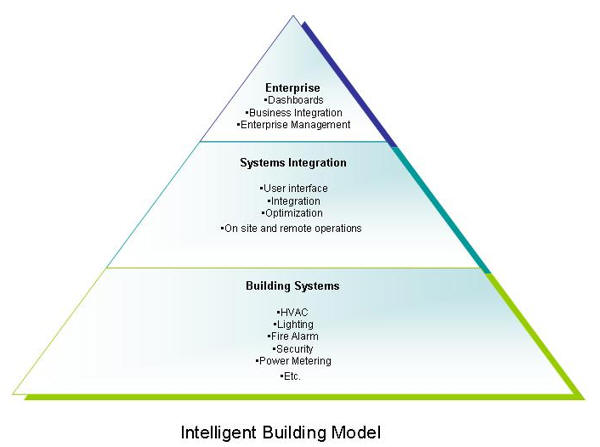September 2008
![]()
AutomatedBuildings.com
[an error occurred while processing this directive]
(Click Message to Learn More)
September 2008 |
[an error occurred while processing this directive] |
|
Differentiating an Intelligent Building These three levels of an Intelligent Building system can result in a significant improvement of system operations, operational efficiency, and high level tools for facility assessment and optimization. |
Paul Ehrlich & Ira Goldschmidt |
We are seeing growing interest in the concept of the Intelligent Building (AKA: Smart Building or Connected Building). Often, however, then we are asked “What is the difference between an Intelligent Building and normal Building Automation?”. This is a good question! It may be valuable to start with a high level definition of an Intelligent Building. The one we like is:
|
|
|
|
|
|
|
|
|
|
|
|
|
|
|
|
|
|
|
|
|
[an error occurred while processing this directive] |
“Use of technology and process to create a sustainable building that is safer and more productive for its occupants and more operationally efficient for its owners.”
In short, this is a focused view of buildings as a system of systems with controls and integration being used to deliver a higher level of efficiency and an improved set of user interface tools. So what differentiates this from traditional building automation? In some ways the whole concept is just an extension of building automation to cover more systems and functions, but in other ways it is completely different. Here are some specific examples:
1. Improved Building Systems Control: The concept of the intelligent building starts with the design and selection of the right building system controls. These systems need to be designed to be properly optimized for efficiency, provide the data needed for efficient operations, and be selected to be IP compatible and use open standards so that they can be readily integrated. In addition to properly specifying and designing these systems they also need to be properly installed and, most importantly correctly commissioned. Building systems are often selected so that they can be competitively acquired from “best in class” suppliers and often will include a set of software tools for setup, troubleshooting, and limited operations.
[an error occurred while processing this directive] 2. Systems Integration: The second tier of an Intelligent Building is the integration layer. This often is based on a “middleware” package that allows for systems to be readily interconnected using a combination of protocols and to provide user interface typically using a series of web pages. At the integration layer information can readily be shared between systems for additional optimization. Web based user interface allows for a single view of all of the building systems and can allow for operations and monitoring on site, from handheld devices such as PDA’s and smart phones or remotely from a web connection.
3. Enterprise Management: The final layer of an Intelligent Building system is Enterprise Management. This is clearly a departure from more traditional building automation. Enterprise management provides connections between the building systems and business systems. Examples of this include using information from a scheduling program, such as Microsoft Exchange server to schedule lights and air conditioning in spaces such as conference rooms. Other examples include bringing information up to management dashboards that allow for easy analysis of building performance including energy, sustainability, and productivity at a high level. Enterprise management also provides tools for managing large groups of buildings as one virtual campus or enterprise. It furthermore allows for ready connection to outside services including utility demand response programs and analytic services that can readily assess building performance and provide recommended improvements.
Used together these three levels of an Intelligent Building system can result in a significant improvement of system operations, operational efficiency, and high level tools for facility assessment and optimization. Keep in mind, however, that the pyramid or hierarchy is only as good as the quality of its base. It starts with a solid design and delivery of the building systems and their associated controls, then builds with integration and connectivity. At a high level the tools provide the ability to recognize and improve on system problems, but for an Intelligent Building to work, all of the underlying systems must be properly designed, implemented and commissioned.

About the Authors
 Paul
and Ira first worked together on a series of ASHRAE projects including the
BACnet committee and Guideline 13 – Specifying DDC Controls. The formation of
Building Intelligence Group provided them the ability to work together
professionally providing assistance to owners with the planning, design and
development of Intelligent Building Systems. Building Intelligence Group
provides services for clients worldwide including leading Universities,
Corporations, and Developers. More information can be found at
www.buildingintelligencegroup.com We also invite you to contact us
directly at
Paul@buildingintelligencegroup.com or
ira@buildingintelligencegroup.com
Paul
and Ira first worked together on a series of ASHRAE projects including the
BACnet committee and Guideline 13 – Specifying DDC Controls. The formation of
Building Intelligence Group provided them the ability to work together
professionally providing assistance to owners with the planning, design and
development of Intelligent Building Systems. Building Intelligence Group
provides services for clients worldwide including leading Universities,
Corporations, and Developers. More information can be found at
www.buildingintelligencegroup.com We also invite you to contact us
directly at
Paul@buildingintelligencegroup.com or
ira@buildingintelligencegroup.com
[an error occurred while processing this directive]
[Click Banner To Learn More]
[Home Page] [The Automator] [About] [Subscribe ] [Contact Us]